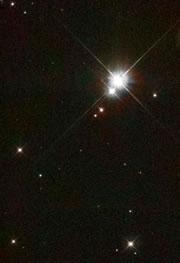 Type Ia supernovae are usually the same brightness — usually.NASA
Type Ia supernovae are usually the same brightness — usually.NASAA particularly brilliant supernova has cast a shadow on a basic assumption about the Universe — one that has helped astronomers get a handle on everything from the distance of stars to the rate at which the universe is expanding.
Astronomers have long relied on stellar explosions called type Ia supernovae to measure the Universe. These explosions happen when a collapsed stellar remnant called a white dwarf sucks up material from a companion star until it reaches a critical mass, exactly 1.4 times the mass of our Sun. At this point it erupts in a thermonuclear blast that is bright enough to outshine an entire galaxy.
Because all such explosions have the same mass they have a very predictable peak brightness — a property that has led to these stars being called 'standard candles'. When such an explosion is spotted, researchers can work out how far away it is by how bright it looks from Earth.
But now, work by a team of astronomers led by Andrew Howell of the University of Toronto, Canada, suggests that at least some type Ia supernovae might be heavier and brighter than others. The team has spotted a rogue, super-bright explosion, they report in Nature1.
One of a kind
The fact that the team has found only one such oddball is reassuring to researchers, who guess that there might be one or two non-standard candles mixed into their databases of hundreds of such explosions. Researchers in the field say that conclusions drawn so far, including the rate of expansion of the Universe, are almost certainly still valid. But we'll have to watch out for such weird stars in the future.
"If one or two are odd, it's not a problem. I would be more worried if these weirdos were around the 10% level — if they had found 20 weirdos," says Adam Riess, an astrophysicist at the Space Telescope Science Institute in Baltimore, Maryland.
But the scope of the problem is far from clear. "We don't know whether this is just one extreme object, or whether there is a continuum of objects like this," says Howell.
Spinning nickel
The oddball supernova in question is called SN 2003fg or SNLS-03D3bb. Howell's group did a spectral analysis of the explosion and confirmed that it was a type Ia event. But, the researchers say, the amount of nickel-56 in the star shows that it must have been about 2.1 times the mass of our Sun when it exploded. That would make it 2.2 times brighter than a typical type Ia.
ADVERTISEMENT
How that could happen, no one yet knows. It is possible that the material falling into the white dwarf had a lot of momentum and accelerated the white dwarf's spin. That might let it gain more mass before exploding. Howell says that such super supernovae are more likely to occur in younger stellar populations where the most massive stars exist.
The notion that anything might not really be 'standard' in our Universe isn't really a huge shock. "As you might expect, as you move from samples of a few dozen to samples of a few hundred supernovae, you are going to begin to see the rare types," says Robert Kirshner of the Harvard-Smithsonian Center for Astrophysics in Cambridge, Massachusetts. "So you should not be too surprised if nature has more varieties of supernovae than we have seen to date."
But it is definitely worth keeping an eye on, he says.
Visit our supernovabreakstherul.html">newsblog to read and post comments about this story.
Corrected:
This article originally stated that Howellthought unusually bright events might make up something like 20% ofall Ia supernovae. This rough estimate includes supernovae that mightbe just a little brighter than usual, and which wouldn't be expectedto muddle up cosmological calculations. It was not meant as a directcomparison to Riess's worries about 10% of stars being super-bright.-
References
- Howell D., Andrew , et al. Nature, 443. 308 - 310 (2006). | Article |
